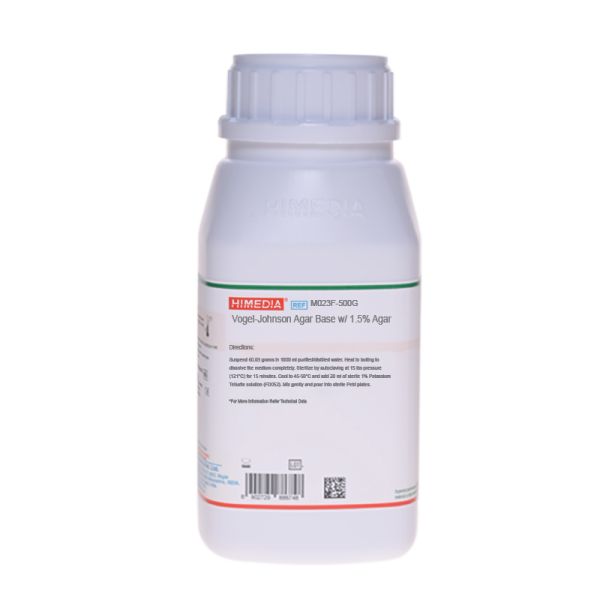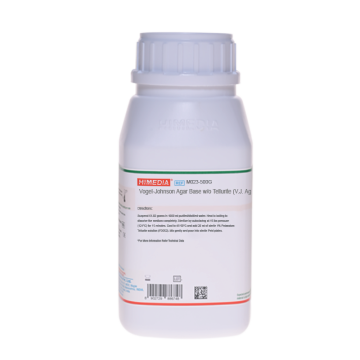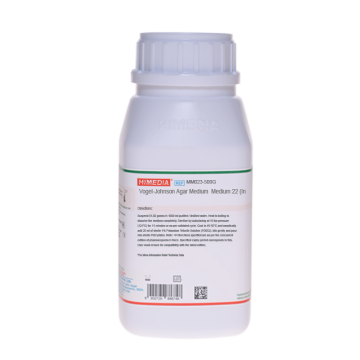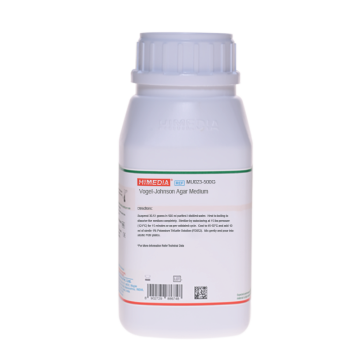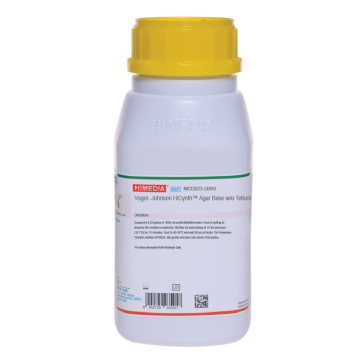 Your enquiry has been submitted
Your enquiry has been submitted
Vogel- Johnson Agar Base w/1.5% Agar
Vogel-Johnson Agar Base w/ 1.5% Agar with addition of potassium tellurite is recommended for selective isolation of coagulase positive, mannitol fermenting Staphylococcus aureus from heavily contaminated foods in accordance with FDA BAM, 1998.
Composition
| Ingredients | Gms / Litre |
|---|---|
| Tryptone | 10.000 |
| Yeast extract | 5.000 |
| Mannitol | 10.000 |
| Dipotassium phosphate | 5.000 |
| Lithium chloride | 5.000 |
| Glycine | 10.000 |
| Phenol red | 0.025 |
| Agar | 15.000 |
Final pH (at 25°C): 7.2±0.2
Formula adjusted, standardized to suit performance parameters
Directions
Suspend 62.03 grams in 1000 ml distilled water. Heat to boiling to dissolve the medium completely. Sterilize by autoclaving at 15 lbs pressure (121°C) for 15 minutes. Cool to 45-50°C and add 20 ml of sterile 1% Potassium Tellurite solution (FD052). Mix gently and pour into sterile Petri plates.
Warning: Lithium chloride is harmful. Avoid bodily contact and inhalation of vapours. On contact with skin, wash with plenty of water immediately.
Principle And Interpretation
Vogel-Johnson Agar Base w/ 1.5% Agar is prepared according to the formula devised by Vogel and Johnson (1) and is recommended for the selective isolation of coagulase positive, mannitol fermenting Staphylococcus aureus from heavily contaminated foods in accordance with FDA BAM, 1998 (2). Staphylococcus aureus, a gram-positive, spherical bacterium, is a common colonizer of the human skin and mucosa. It causes skin and wound infections, urinary tract infections, pneumonia and bacteremia. It is also commonly implicated in food poisoning and as a common contaminant in cosmetics and pharmaceutical products (2). Originally it was developed by Zebovitz (3), as Tellurite Glycine Agar, a selective medium for the detection of coagulase-positive staphylococci. Vogel-Johnson modified the medium in 1960 by the addition of phenol red as a pH indicator and by increasing the quantity of mannitol (1). Selection and differentiation of coagulase-positive staphylococci on V.J. Agar is based on mannitol fermentation and tellurite reduction (4). Vogel-Johnson Agar Base w/ 1.5% Agar can also be used in the enumeration and identification of microbes from cosmetics wherein Staphylococcus contamination is expected.
Tryptone and yeast extract provide nitrogenous compounds, vitamin B complex and other growth nutrients. Dipotassium phosphate provides buffering to the medium. During the first 24 hours of incubation, contaminating organisms are almost inhibited by tellurite, lithium chloride and high glycine content. The effect of inhibitors on S. aureus is reduced because of the presence of mannitol and glycine. Coagulase-positive staphylococci reduce potassium tellurite to metallic free tellurium and thus produce black colonies surrounded by yellow zones. This yellow colour is due to phenol red indicator that turns yellow in acidic condition due to the fermentation of mannitol. If mannitol is not fermented, yellow zones are not formed. Also the colour of the medium around the colonies may even be a deeper red than normal due to utilization of the peptones in the medium. Prolonged incubation may result in the growth of black coagulase-negative colonies.
Quality Control
Appearance: Light yellow to pink homogeneous free flowing powder
Gelling: Firm, comparable with 1.5% Agar gel.
Colour and Clarity of prepared medium: Red coloured clear to slightly opalescent gel forms in Petri plates.
Reaction: Reaction of 6.03% w/v aqueous solution at 25°C. pH: 7.2±0.2
pH: 7.00-7.40
Cultural Response
Cultural characteristics observed with added 1% Potassium Tellurite solution (FD052), after an incubation at 35-37°C for 24-48 hours.
| Organism | Inoculum (CFU) | Growth | Recovery | Colour of colony | Mannitol fermentation |
|---|---|---|---|---|---|
| Escherichia coli ATCC 25922 | >=10³ | inhibited | 0% | ||
| Proteus mirabilis ATCC 25933 | 50-100 | poor | 10-20% | black | |
| Staphylococcus aureus ATCC 25923 | 50-100 | luxuriant | >=50% | black with yellow halo | positive |
| Staphylococcus epidermidis ATCC 12228 | 50-100 | Fair-good | 30-40% | translucent to blackish | |
| Escherichia coli NCTC 9002 | >=10³ | inhibited | 0% | ||
| Escherichia coli ATCC 8739 | >=10³ | inhibited | 0% | ||
| Staphylococcus aureus ATCC 6538 | 50-100 | luxuriant | >=50% | black with yellow halo | positive |
| Staphylococcus aureus NCIMB 9518 | 50-100 | luxuriant | >=50% | black with yellow halo | positive |
Storage and Shelf Life
Store below 30°C in tightly closed container and the prepared medium at 2 -8°C. Use before expiry date on the label.
Reference
- Vogel R. A. and Johnson M. J., 1960, Public Health Lab. 18:131.
- FDA, U.S. 1998. Bacteriological Analytical Manual. 8 ed. Gaithersburg, Md.: AOAC International.
- Zebovitz E., Evans J. B. and Niven C. F., 1955, J. Bacteriol., 70:686.
- MacFaddin, J. F. 1985. Media for Isolation-Cultivation-Identification-Maintenance of Medical Bacteria. vol. 1. Baltimore: Williams and Wilkins.
| Product Name | Vogel- Johnson Agar Base w/1.5% Agar |
|---|---|
| SKU | M023F |
| Product Type | Regular |
| Physical Form | Powder |
| Origin | Animal |
| Packaging type | HDPE |
| References | 1. Vogel R. A. and Johnson M. J., 1960, Public Health Lab. 18:131. 2.United States Pharmacopeia, 200 3.Zebovitz E., Evans J. B. and Niven C. F., 1955, J. Bacteriol., 70:686. 4.FDA Bacteriological Analytical Manual, 2005, 18th Ed., AOAC, Washington, D.C. 5.MacFaddin J. F., 1985, Media for Isolation-Cultivation-Identification-Maintenance of Medical Bacteria, Vol. 1, Williams& Wilkins, Baltimore, Md. 6.Curry A. S., Graf J. G. and McEwen G. M., (Eds.), 1993, CTFA Microbiology Guidelines, The Cosmetic, Toiletry andFragrance Association, Washington, D.C. |
| Customized Product Available | No |



